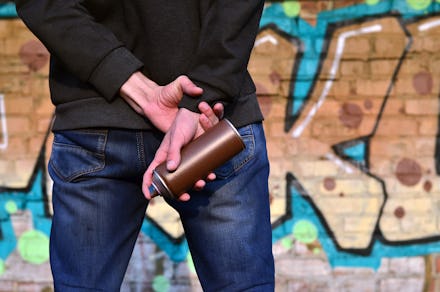Teens painted hate speech on a high school. Instead of criminal charges, officials hope for healing.

Like most suburbs, Arlington, Massachusetts, is no stranger to graffiti and petty vandalism. But the town of about 44,000, which is a few miles outside of Boston, was shocked by the extent of the damage done to the local high school by students in early May. Display cases were smashed, fire extinguishers discharged, vending machines destroyed, and, more alarmingly, the walls were tagged with swastikas and homophobic messages.
“What occurred earlier this month was deeply upsetting on a multitude of levels, and it does not represent either the image we have in mind for our community or the beliefs of our residents and young people,” a joint statement from the town officials, including town manager Adam Chapdelaine, police Chief Frederick Ryan, and superintendent of schools Kathleen Bodie said.
“We have seen the number of these incidents rise, whether it be swastikas, racist, ethnic, anti-gay, hateful graffiti on the bike path, on private property and in school bathrooms,” Naomi Greenfield of the Arlington Human Rights Commission said at a town meeting shortly after the incident. She also expressed her dismay at the “many hate-inspired incidents in Arlington” that has happened in the past year and a half.
With racist offenses and anti-semitic speech on the rise, the town found themselves at a crossroads. How should town officials send the message that this sort of behavior would not be tolerated, but also find ways to help heal the community?
The 14 male students involved were identified as responsible, but instead of criminal charges, an alternative was proposed by town officials. The boys would be offered the chance to participate in a restorative justice program.
Restorative justice, a practice that can be traced back to ancient, indigenous communities around the world, is, as the Center for Justice & Reconciliation explains, “a theory of justice that emphasizes repairing the harm caused by criminal behavior. It is best accomplished through cooperative processes that include all stakeholders. This can lead to transformation of people, relationships and communities.” Restorative justice is also an attempt to address a broad range of failures in the criminal justice system, from overcrowded prisons, racial disparity in arrests, recidivism, and the over reliance on the police for incidents that could possibly be solved with community-based solutions.
The town of Arlington’s decision came just as Massachusetts passed a sweeping criminal justice reform bill, which, like many other states have, or are attempting to, codify the option for restorative justice measures into law. But Arlington, along with 20 other cities and towns in the state, have long participated in a similar program as part of a group called Communities for Restorative Justice. The approach centers the crime as being against the victim and the community as opposed to against the state.
While such measures have been used around the country, often as a means of rehabilitating serious offenders, in Arlington, it’s most frequently employed for youthful offenders without any prior criminal record, or people who’ve committed crimes like breaking and entering, assault and battery, larceny and vandalism.
“It’s an opportunity to bring in the offender to make amends, acknowledge the harm, and provide restitution for whatever the harm might be, but also have a learning outcome come out of the process,” Chapdelaine said in an interview with Mic.
Chapdelaine had met with members of the community, including the police chief, the Human Rights Commission and the LGBTQIA Rainbow Commission after the incident to discuss a proper outcome. It was the latter two groups, he said, who pushed for a restorative justice approach.
“In this sort of polarized state in the country you could have an outcome where students who did these things that maybe would get more entrenched in whatever it was that made them do what they did and not really learn much, and you’d have a community that feels badly about what happened,” he said. “Or you could try to teach those offenders why what they did was so harmful, and come out learning more about it, and hopefully never do it again.”
Chapdelaine declined to share any information about the students in question. However, a second town official confirmed that there was more than one nonwhite student involved. If a traditional approach were taken, the students and their families would likely be made to pay a fine in court, and that would be the end of it, the official added. Instead, these 14 students — who have decided to participate in this program — will have to put in some work.
The offenders and victims will be brought together to start a dialogue facilitated by stakeholders of those who were harmed, in this case members of the town’s human rights and LGBTQIA groups. The harm will be discussed and a contract will be agreed upon by both parties laying out steps toward righting the wrong.
“That often includes the writing of a letter of reflection, and it’s expected a lot of research would go into it that would look at that harm,” Chapdelaine said. “In this case with the homophobic, anti-semitic graffiti we’d expect they would have to do a lot of research about why those words are so hurtful and what they mean so they can gain a deeper understanding of why what they did is so wrong.”
In addition, financial restitution and community service responsibilities are often expected. At the end of the process, the parties involved return to the table to decide whether or not the contract has been fulfilled.